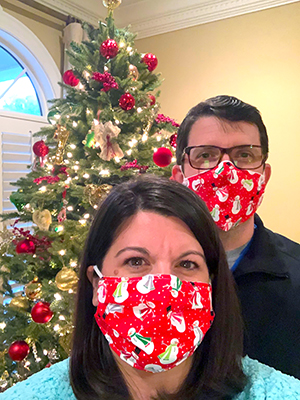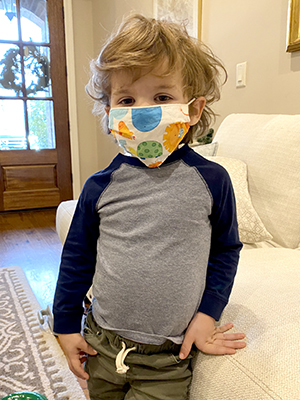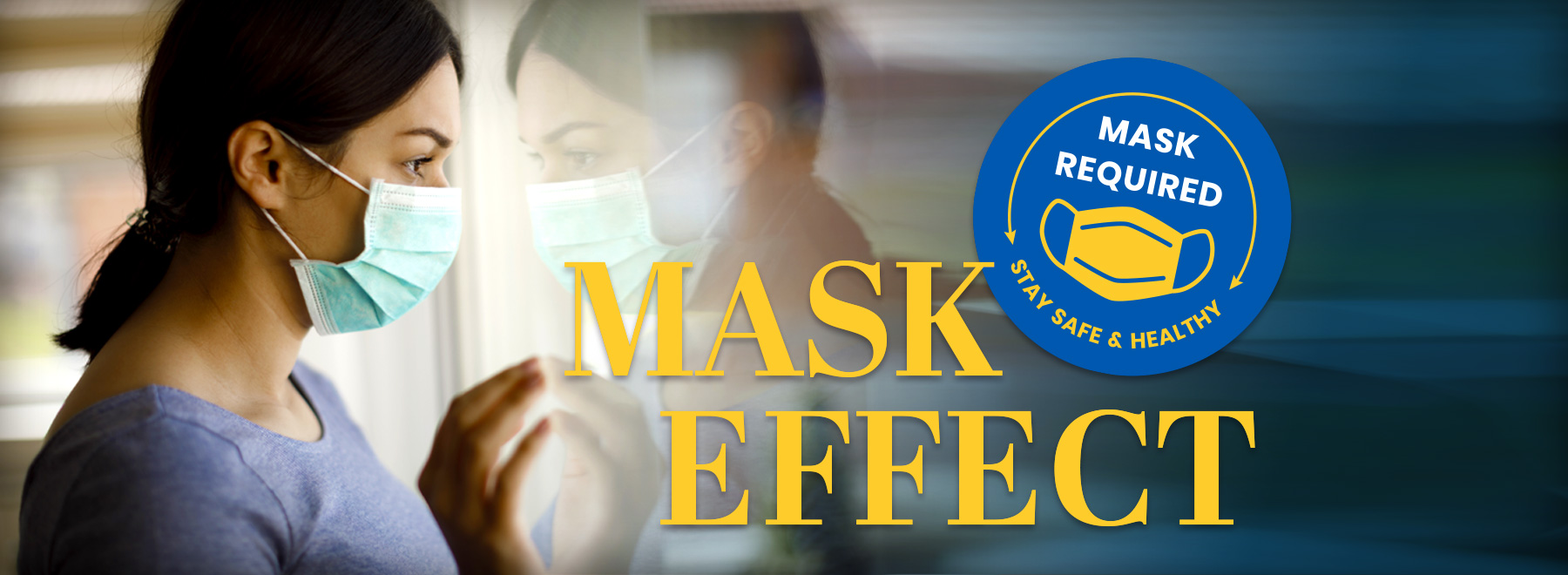Are facial coverings truly effective against COVID-19 spread?
DeAnna Dillard won’t soon forget the text message she received from her husband on March 11, 2020.
Dr. Benjamin C. Dillard, division chief of emergency pediatrics at the University of Mississippi Medical Center, hadn’t been at work long that day before he sent her a request - actually, more of a plea: Could she make cloth masks for the physicians and nurses in his department?
“Benji texted from the ER, ‘We’ve got our first (COVID-19) case in,” Dillard said, “and they needed masks. I asked him if it was really coming down to that.
“He told me, ‘Yeah, we’re going to be wearing masks for at least a year.’”
So DeAnna Dillard, executive director of the Mississippi Chapter of the American Academy of Pediatrics and a former staff member in the UMMC Department of Family Medicine, climbed the stairs to her home sewing room and set to work.
— — —
Are cloth masks actually effective in the incessant battle against COVID-19? That has been the subject of much debate since before DeAnna Dillard ever attempted to make her first mask.

Those on both sides of the argument point to scientific evidence to suggest their opinion is the correct one. While it may be true the actual size of COVID-19 particles is way too small for any cloth barrier to completely arrest, according to Dr. Jose A. Lucar Lloveras, medical director of the Division of Infectious Diseases at UMMC, scientific data overwhelmingly suggest that widespread and correct usage of cloth facial coverings does inhibit spread of the infection.
“There are now several experimental, observational and epidemiological studies that have provided evidence supporting the effectiveness of community masking to limit the spread of COVID-19,” Lucar said. “These include studies exploring the filtering effectiveness of different types of cloth masks, observational reports related to high-risk exposure events and contact tracing investigations, as well as community level analyses.
“Taking all of these studies together, there is, in my opinion, a solid justification to support community masking to reduce the spread of COVID-19.”
— — —

It took practice - and some meticulous research - before Dillard was able to hit her stride making durable cloth facial coverings. She looked into what type of mask molded to people’s faces the best, which style seemed to be the most popular, which fabrics yielded the greatest protection.
Because of the early demand for cloth masks, she had a hard time finding fabric. So she tried what she already had on hand at her home in Clinton, from bandanas to pillowcases. She discovered the basic pleated mask made of 100 percent tightly woven cotton and a light flannel to be the most versatile covering.
Word about her efforts soon spread and the demand for her custom-made masks increased. She made masks and surgical caps for all of the doctors and nurses in the Pediatric Emergency Department at UMMC.
“I first started making them for free, but I had so many people ask for them, people started donating money to help pay the cost for materials,” she said. “Luckily, fabric stores were deemed essential businesses, so I was able to stock up on material, elastic and thread.”
After a month, her sewing machine died, so she started using her mother-in-law’s. Then she got a brand new one as an early Mother’s Day present. And her work continued.
— — —
Lucar said wearing facial coverings is particularly important when social distancing is difficult, such as when riding on public transportation, working indoors or shopping in grocery stores.
“Wearing masks in the community should be considered part of a comprehensive preventive approach in addition to other personal preventive measures,” he said. “Those include avoiding crowds, maintaining a distance of at least six feet from others when in public, ensuring the adequate ventilation of indoor spaces, adequate hand washing or use of hand sanitizer - especially after touching surfaces in public - and following basic respiratory etiquette principles like covering your nose and mouth when coughing or sneezing.”
He said the lack of good evidence early in the pandemic about how COVID-19 is transmitted - including how asymptomatic individuals could unknowingly spread the virus - was the main reason public health recommendations about wearing masks seemed inconsistent. A shortage of medical-grade masks at the time also contributed to the perception that facial coverings should be saved for health care personnel only.
While there is still more to learn about COVID-19, Lucar said direct person-to-person transmission through respiratory particles is the primary way individuals become infected.
“These particles, also known as droplets, can be released by an infected individual through coughing, sneezing, talking and even singing, and the uninfected individual acquires the infection when these droplets are inhaled or through contact with their mucosal membranes,” Lucar said. “These droplets can be of different sizes, and subsequently behave differently depending on that.”
For example, larger droplets will rapidly fall to the ground due to gravity, but smaller droplets, also referred to as aerosols, may remain in the air for some time and travel longer distances. Lucar said both seem to play an important role in person-to-person spread, and ongoing research is trying to determine the extent to which each of these modes of transmission have contributed to the pandemic. However, current evidence and general scientific consensus supports that transmission through close-range contact by larger droplets is likely to be the most common source of transmission.
“It is true that different kinds of masks - such as N95, surgical or cloth - and facial coverings - such as bandannas or neck gaiters - offer different levels of particle filtration,” Lucar said. “But it is key to understand that even if cloth masks have less filtration efficiency than, let’s say, N95 masks, there is early evidence showing that cloth masks - especially those with multiple layers and/or higher thread counts - can significantly block the release and limit the forward spread of exhaled respiratory particles into the environment, including both larger and smaller droplets.
“This is a key principle explaining how mask wearing can control the spread of the virus, including from asymptomatic or pre-symptomatic infected individuals.”
He said there is preliminary evidence that cloth masks also may offer personal protection by reducing the wearers’ exposure to infectious droplets.
“Some studies even suggest that masks might reduce the severity of infection even if you catch it, although that remains a controversial topic,” he said. “On the other hand, the frequently used neck gaiters (stretchable scarves that can be pulled over the mouth and nose) probably offer the least degree of protection compared to other face coverings.”
— — —
When experts recommended children ages 2 and older should also wear facial coverings, Dillard figured out how to measure tiny faces so she could produce masks in smaller sizes. She used a variety of patterns to churn out masks that would appeal to children and adults alike - from camouflage and superheroes to college and sports teams. She created an online form so wearers could select the size and fabric they preferred.

She ruined her manicure, but she developed some impressive skills: After creating more than 1,600 facial coverings in eight months, she can churn out a completed made-to-order mask in less than five minutes. For a time, she was producing about 20 masks a day while also working remotely.
She even made 50 golden yellow masks for seniors and faculty at the Mississippi School for the Deaf to coordinate with their 2020 commencement regalia.
“It’s been therapeutic,” she said. “When I’m at my sewing machine I usually have some music playing in the background and I pray for the people who will be wearing these masks and scrub caps. I also think about my mother a lot, as she is the one who taught me how to sew when I was 10 years old. She died in 2019. I would like to think that she is smiling down on me. She would definitely be sewing right alongside me if she were here.
“I continue to make masks to help others show they care by being responsible and respectful. I’ve reconnected with a lot of people - old classmates and family members. It’s also been a ministry - the extra funds that I have received go back to my church and to purchase more material.”
— — —
Despite the scientific evidence, Lucar said a lot of misinformation about mask wearing still exists.
“For example, some have said that wearing a mask will increase the amount of carbon dioxide in their lungs or will decrease the amount of oxygen and subsequently make them sick,” he said. “There is no scientific evidence to support these claims. Carbon dioxide is a gas made up of very small molecules, small enough that they pass through the materials used to make masks. In healthy adults, there is no risk of lowering oxygen levels while wearing a mask.
“It is important to note that masks may be new for many people, but for decades, health care workers have worn face masks for prolonged periods of time with no adverse reactions.”
Ultimately, Lucar said there is “mounting scientific evidence suggesting that, in addition to blocking exhaled virus in those who are already infected, cloth masks actually do offer personal protection to the wearer as well.”
While keeping up with all of the recommendations and restrictions experts suggest to contain the spread of COVID-19 can be exhausting unto itself, Lucar said everyone shares a responsibility to protect themselves, those they love - and the community.
“The current best available evidence is very supportive of using face masks to curtail the spread of COVID-19, but particularly when most people are wearing them,” he said. “They are unlikely to be effective if only some do.
“In addition to physical distancing, limiting large gatherings, improving indoor ventilation and hygiene efforts, and moving most activities outdoors, cloth mask wearing is also a relatively simple way to keep our businesses and economy open. They are not perfect, nor are they the single solution on their own. But masks work - and we all can do our part to save lives.”
— — —
For her part, DeAnna Dillard said she will continue to make facial coverings because she has seen the difference they have made during a trying time for everyone.
“The science and data have all proven that the wearing of masks slows down the spread of the virus,” she said. “Wearing a mask when around other people shows you care for those people. Use the fabric masks as a fashion statement - match a favorite outfit, support your favorite team, show your hobbies.
“Yes, it’s a minor inconvenience at times, but it’s worth it knowing that I could help prevent someone else from getting sick. It’s something we should do because it’s the right thing to do.”
The above article appears in CONSULT, UMMC’s monthly e-newsletter sharing news about cutting-edge clinical and health science education advances and innovative biomedical research at the Medical Center and giving you tips and suggestions on how you and the people you love can live a healthier life. Click here and enter your email address to receive CONSULT free of charge. You may cancel at any time.



